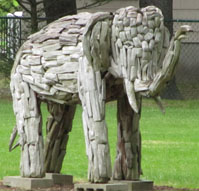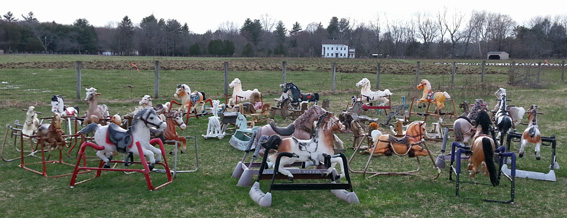
The first animal we see is on the left, at the corner of Lincoln Road. It's an elephant, as you can see. Well, actually, it's an unusual outdoor statue of an elephant, which appears to be made out of pieces of wood. It sets the mood for some of the other unusual sights yet to come. The next set of animals can't be seen anymore, because spring has arrived. But briefly, during the winter just past, you could see the tableau shown below. It depicted a common scene: a mother duck followed by a line of ducklings. Except these weren't real ducks, they were rubber duckies. Except they weren't actually made of rubber, they were made of snow, and were much larger than the usual rubber duckies. I'd guess that the large one in front was 1.2 meters high (about 4 feet). Obviously, whoever created these put in a great deal of effort, and had a good sense of humor. The sign hanging from the mailbox reads "SLOW RUBBER DUCKIES X-ING". You can see that the snow was melting when we came across them, and I doubt they lasted much longer. Note 2 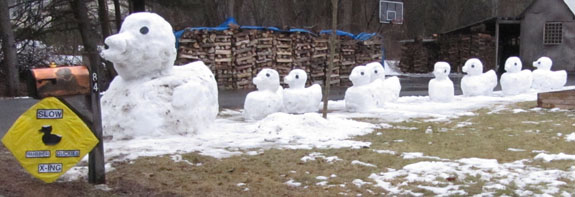 Waltham Road is in the extreme north-eastern corner of Wayland, and the name of the road changes to Old Sudbury Road as it leaves Wayland and crosses into Lincoln. A bit farther along, on the left side (seen in the image below), there is generally a herd of cattle in a field. These seem to be bulls, not cows. When I stopped to take a picture yesterday, one of them came up to me at the fence, perhaps thinking I had something to feed him. A passing cyclist commented, "He wants to ask you for a copy of the picture." I replied, "I don't think he has an e-mail address." 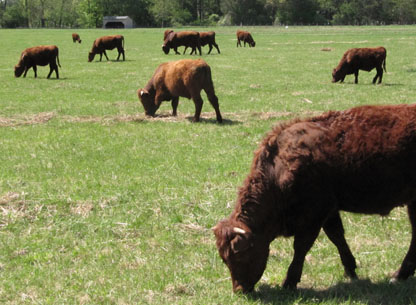 We usually see the cattle standing quietly in groups, munching on the grass. They're often mixed in with flocks of Canada geese, a few of which can be seen in the picture below to the left. In a rare show of energy yesterday, one of the bulls broke into a run across the field, and I captured him on the move with my camera (below right). 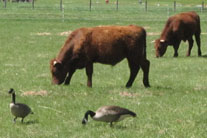 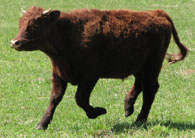 On the right side of the road, the fields are generally full of sheep. Earlier today, I found them huddled under a tree to stay out of the rain. But when I approached to take a picture, they jumped up and backed off a bit.  Wherever the sheep are (they are moved around into various portions of the field), there are generally also a couple of large llamas, shown below: Note 3 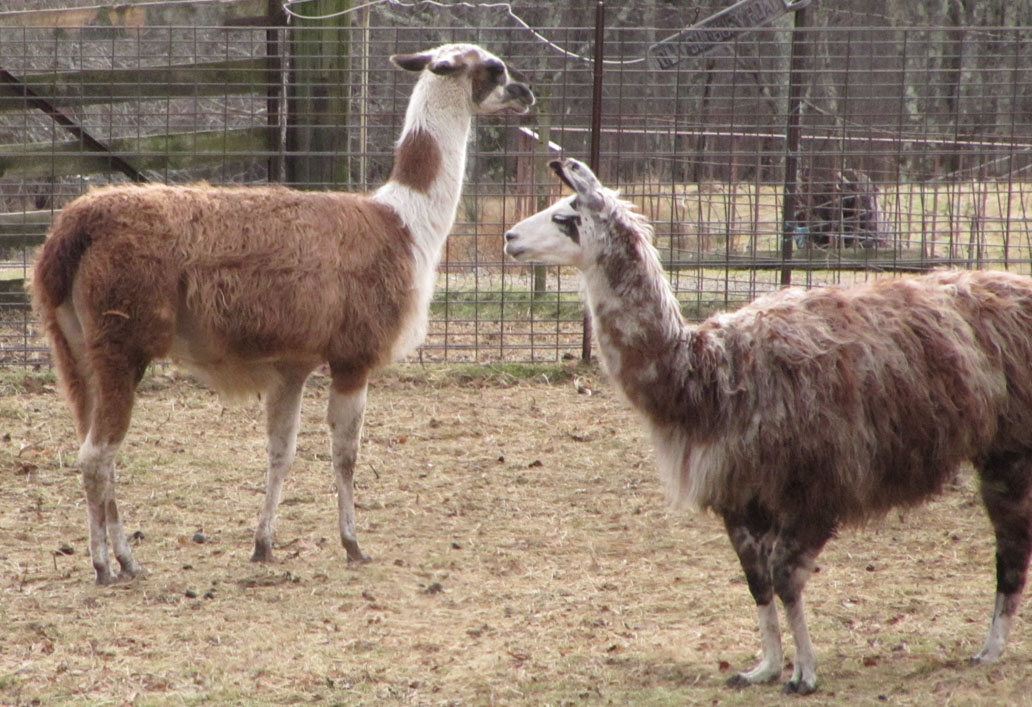 Further along, on the left side of the road, there's something strange, which you can see below. It's a circle of hobby horses. I have no idea where they came from, or why someone decided to put them there. It seems to me that they've been there for years, although the circle started with only a few horses, and gradually grew over time.  On one occasion, I saw a couple of cars stop, and a group of children came out to play on them. Actually, that's not a good idea. A web search showed that many of these are what are called "Wonder Horses", which may be a safety hazard. Certain models of these were recalled by their manufacturer, CBS Toys, because the plastic bodies of the horses broke, sometimes causing injuries. September 5, 2015 update: The Boston Globe had a front-page story about the rocking horses, entitled: Click on that link to see the story on the Globe's web site, which includes a link to a gallery with a lot more pictures of the horses. The web version also includes a short video in which Lincoln resident Harold McAleer shows off the horses. Return here with your browser's Back button. April 3, 2016 update: The Boston Globe article seems to have provoked quite a few more people to drop off horses. Below is a photo of what the site looked like on March 31, 2016, in a photo taken on my cellphone: For a short stretch of road, Waltham Road/Old Sudbury Road has a lot of interesting things to see. And that's just the animals. Perhaps some day I'll do a blog entry on the interesting houses.
  Note 1: Curiously, as of the posting of this entry on May 22, 2014, the mapping website MapQuest.com shows the name of this road to be "Waltham Road" along its entire length, while Google maps shows the name changing to "Old Sudbury Road" at the Lincoln town line. A paper map that I have confirms that "Old Sudbury Road" is the name of the road in Lincoln. Only a single sign on the road itself, at the eastern end, displays this name. Massachusetts is not very good with road signs. [return to text] Note 2: Many years ago, when Margie was pregnant with Elissa, I built a snowman to amuse myself. This was on a visit to my uncle Bill and aunt Barbara's place in Tannersville, New York, in the Catskill mountains. But instead of a conventional snowman, I created a snow sculpture of a nude woman with a pregnant belly. A neighbor enjoyed it, and commented on it to Bill. Unfortunately I don't have a picture of it. [return to text] Note 3: Sheep can be troubled by predation from animals like coyotes, and llamas can protect them from this. A llama, being quite a large animal, can intimidate coyotes, and at the very least, it will emit loud screaming noises at any indication of trouble. When used this way, they are called "guard llamas", as explained in this Wikipedia article on the subject. How can I resist a linguistic note! The word llama has three different meanings in Spanish. The first two come from the fact that when words in Latin start with a consonant followed by an L, the consonant-L frequently turned into a double-L in Spanish (which, by the way, is pronounced like a Y). Thus the Latin FLAMMA, meaning flame, turned into llama in Spanish (it still means flame). And the Latin CLAMARE, meaning "to call", turned into llamar in Spanish, so that Se llama Juan means "His name is Juan" (literally "He calls himself Juan"). Of course the animal we've been speaking of is called a llama in Spanish as well. But that's just a coincidence that has nothing to do with Latin. The name of the animal comes from a native Peruvian language, probably quechua. [return to text]  |
